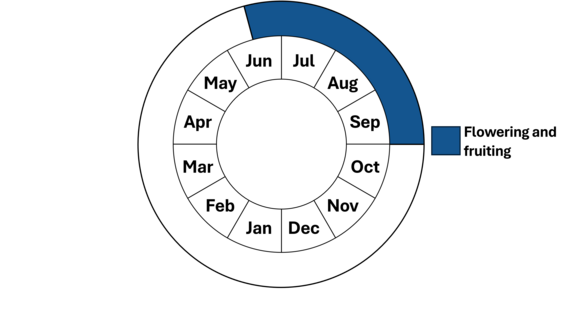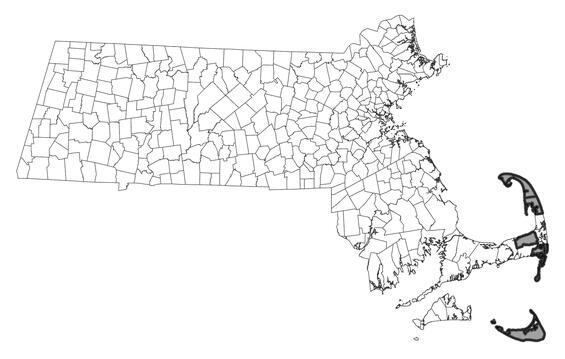- Scientific name: Mertensia maritima
- Species of Greatest Conservation Need (MA State Wildlife Action Plan)
- Endangered (MA Endangered Species Act)
Description

Oysterleaf (Mertensia maritima)
Oysterleaf (Mertensia maritima) is a low-growing perennial wildflower of the forget-me-not family (Boraginaceae), found in sandy coastal habitats such as beaches, spits, and foredunes of northern North America.
Oysterleaf is a fleshy sprawling plant, up to 1 m (about 40 in) in length, with a white waxy cast throughout. The leaves are opposite, succulent, egg- to spoon-shaped, and 2-6 cm (0.8-2.4 in) in length. They have smooth margins and broad petioles. The flowers are borne in dense, leafy, axillary clusters, which can be very numerous. The petals are five-lobed and tube-shaped, and enclosed by much shorter, pointed sepals. The flowers, which begin to bloom in early summer, are first pinkish in color, and then become pale blue with maturity. The fruits of oysterleaf are smooth, sharply angled nutlets, which mature from July to September.
Oysterleaf does not closely resemble any other native plant species in Massachusetts.
Life cycle and behavior

Population status
Oysterleaf is listed under the Massachusetts Endangered Species Act as endangered. All listed species are legally protected from killing, collection, possession, or sale, and from activities that would destroy habitat and thus directly or indirectly cause mortality or disrupt critical behaviors. The Massachusetts Natural Heritage & Endangered Species Program has 17 records from 2 counties: Barnstable and Nantucket. Six of these records have been observed within the last 25 years.

Distribution in Massachusetts. 1999-2024. Based on records in the Natural Heritage Database.
Distribution and abundance
Oysterleaf is a northern species, known in North America from much of Canada, including the far northern territories, and from eastern New England; it is at the southern edge of its range in Massachusetts.
Habitat
Oysterleaf inhabits sparsely vegetated sandy coastal habitats, such as the upper reaches of beaches, sand spits, and foredunes. It is found above the wrack line but often within the reach of the highest tides. Because oysterleaf grows in dynamic, high-stress habitats with shifting substrate, it requires large contiguous expanses of habitat to re-establish in the inevitable event of physical destruction by physical forces of nature.
Associated species in Massachusetts include dune grass (Ammophila brevigulata), seaside goldenrod (Solidago sempervirens), beach pea (Lathyrus japonica), sea rocket (Cakile edentula), sea milkwort (Lysimachia maritima), and seabeach knotweed (Polygonum glaucum; special concern).
Healthy habitats are vital for supporting native wildlife and plants. Explore habitats and learn about conservation and restoration in Massachusetts.
Threats
Threats to oysterleaf include any activities that reduce available habitat, or that result in trampling of vegetation and soil disturbance. Specifically, shoreline development and heavy recreational use of beaches greatly threaten this species. Pedestrian and over-sand vehicle traffic, and beach activities such as digging, sunbathing, and beach sports can greatly disturb the vegetation and the soil.
Conservation
Over-sand vehicle and foot traffic should be excluded from oysterleaf population locations to reduce the risk of damage to the rare plants and disturbance of the soil. Oysterleaf habitat can be roped off and posted with explanatory signage in a similar manner to what is commonly done to protect nesting shorebirds.
Population locations should be monitored regularly for invasion by exotic plant species such as sea poppy (Glaucium flavum) and scotch broom (Cytisus scoparius) in the upper reaches of beaches and dune areas. If populations of exotic plants are discovered, they should be closely monitored. Plans for removal should be developed in consultation with MassWildlife’s Natural Heritage & Endangered Species Program (NHESP). All active management of rare plant populations (including invasive species removal) is subject to review under the Massachusetts Endangered Species Act and should be planned in close consultation with the NHESP.
Contact
| Date published: | May 8, 2025 |
|---|